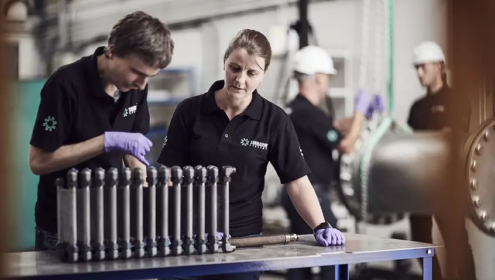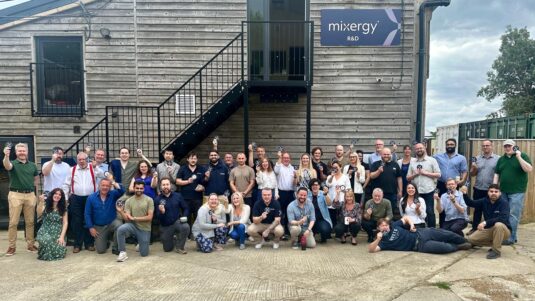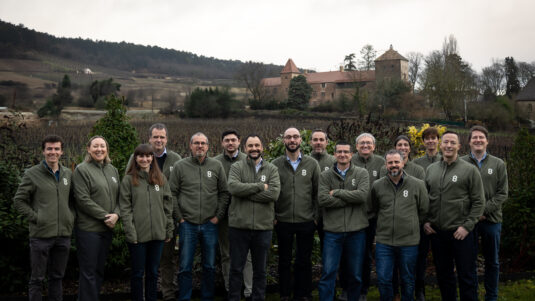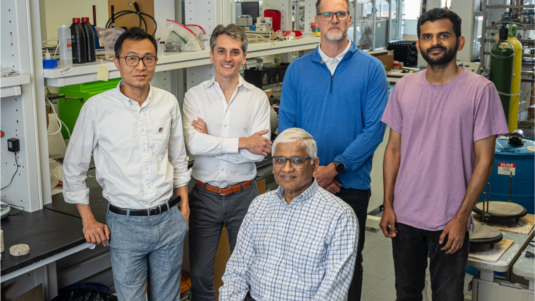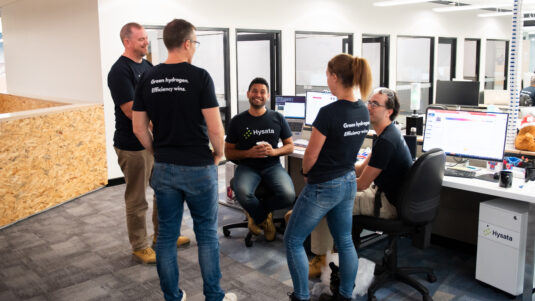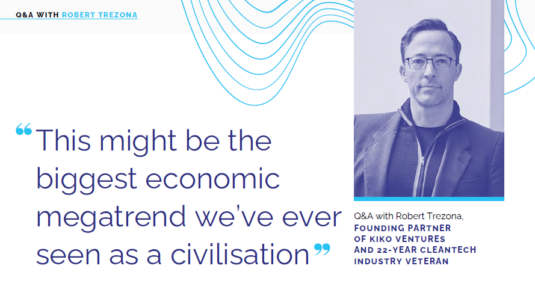We set up Kiko Ventures to create new possibilities for decarbonising our economy. One of the most exciting recent developments in the roadmap to net zero is a growing body of research that suggests that green ammonia, produced using renewable energy, could be key to slashing emissions from hard to abate sectors like shipping and distributed generation.
Ammonia is important but challenging: a new energy vector for the net zero economy that uses new chemistry. In building Sunborne Systems we have used the flexibility in the Kiko approach to co-found a company where we saw a gap in the innovation system, in this case in enabling efficient use of ammonia in existing engines.
How to solve a problem like decarbonising shipping
Decarbonising shipping, which accounts for ca. 1 Gt (2.5%) of all emissions, is one of the most challenging problems in achieving net zero. The high sustained power requirements of long sea journeys mean that batteries are not a practical solution. Container ships also have long asset lives: many of the vessels that will be operating in 2050 are already in the seas now. This means that technologies that can be used with existing engines are particularly important.
In addition to our investment work, Kiko is also actively involved in policy thinking for net zero, a large part of which is our involvement with the Energy Transitions Commission (ETC), a leading global green think tank. Work with the ETC was one of the first analyses to identify combustion of green ammonia as the likely best solution for shipping. If produced from green hydrogen, ammonia can be a zero-carbon fuel, and it can also be used in combustion engines, including as a retrofit to existing vessels. Ammonia is also a widely traded commodity (used mostly as an input to fertiliser), and there is already extensive ammonia handling and storage infrastructure at seaports.
We first published our conclusions around ammonia for shipping in the Mission Possible report in 2018, and since then use of ammonia has been widely adopted in shipping decarbonisation plans.
While it has good energy density as a fuel, pure ammonia is difficult to combust due to its low flame speed. This requires it to either be blended with a “pilot” hydrocarbon or to be partially split (“cracked”) into a mix of ammonia and hydrogen. The pilot fuel approach creates carbon emissions and means that ships need two separate fuel supply systems, adding cost and complexity. Splitting the ammonia in a mix of hydrogen and ammonia retains the zero-carbon nature of the fuel, but heat is required as an input to the cracking reaction, meaning that up to a third of the energy stored in the ammonia is lost.
Introducing Sunborne Systems
Professor Bill David FRS is a leading academic in our network working at Oxford and the Science and Technologies Facilities Council (STFC). Bill has an inspiring vision for the role ammonia can play in global energy systems and has developed an idea for how to efficiently achieve ammonia cracking. When work he was doing on hydrogen storage serendipitously led to the discovery of a new class of ammonia catalyst that operates at lower temperatures, Bill realised that it might be possible to use waste heat from engines to power the cracking process. To take his idea forward, he approached Reaction Engines, a space propulsion company that had developed heat exchanger technology with unprecedented thermal power and efficiency. Working together, STFC and Reaction Engines carried out proof of concept analyses showing how waste heat from a range of combustion engines could be used to drive the ammonia cracking reaction, and showed how the resulting fuel mix could be delivered to engines at the right pressure to provide the same heat energy, meaning minimal modification. Following publication of these results, we engaged with Reaction Engines, and met their co-founder and CTO Richard Varvill and ammonia project lead James Barth, a rocket scientist who shared Bill’s vision.
A talented team and some great technologies were coming together around this important application in ammonia. Kiko’s role was venture building: to mould the people and technology into a business. We structured a joint venture company that pulled in the key IP from STFC and Reaction Engines and provided its first seed capital. James, Richard and Bill were joined by additional talent from Reaction Engines and STFC to form a strong founder group and board. We announced the joint venture at the COP26 Climate Conference in Glasgow last year, and Sunborne has since developed pilot scale reactors and built a high-profile brand in the ammonia space.
Sunborne is an example of our ability and appetite to engage in venture building for high potential technology propositions in important decarbonisation areas. We structured and incorporated the company, put in the initial funding, guided its strategy and most recently sourced a high-quality chairman in Peter Collins. Peter is a serial entrepreneur and angel investor with a strong engineering and cleantech background. We used our talent function to find and engage him, and his appointment this week is a significant step forward for Sunborne.
Provision of zero-carbon fuel systems for shipping is a new market worth 10s of billions and Sunborne has attracted significant interest from shipping and engine companies with its unique proposition. We’re early in the development of this technology but its potential and relevance to a zero-carbon future is clear.
Investing in possibilities for a regenerative future
Sunborne Systems is exactly the type of company that Kiko was founded to support. The company has been borne out of a decade of intensive research and development that could lead to a true energy revolution.
It’s also the type of company that represents the need for investors like Kiko. A venture like Sunborne needs a long-term, high-conviction investor that can fully support its vision to build transformative cleantech, which we can do because of our evergreen structure. Building the decarbonising technology that will transform industries such as marine shipping is exactly the kind of initiative we set out with a mission to back when we launched the Kiko platform earlier this year.
In the future, you could be receiving a parcel that has been delivered on a green ammonia-powered ship – made possible because of companies like Sunborne Systems.
